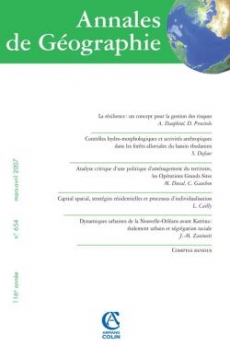
Annales de Géographie n° 654 (2/2007)
Pour acheter ce numéro, contactez-nous
Recevez les numéros de l'année en cours et accédez à l'intégralité des articles en ligne.
À partir d’une enquête sur les conduites résidentielles à l’intérieur de l’aire urbaine de Tours (France), cet article montre comment la mobilisation du concept de capital spatial, dans ce champ d’étude, permet d’améliorer la compréhension des identités résidentielles, de leur formation et de leurs dynamiques. Appréhendé dans une perspective légitimiste, le capital résidentiel des individus (qui constitue une composante du capital spatial) confirme la perdurance voire le renforcement des effets de position, en rapport avec la dotation en capital économique et/ou en capital culturel. Saisi dans une perspective individualiste , il révèle la puissante individualisation des choix d’habitat et permet d’en comprendre la complexité. Ainsi, appliqué aux stratégies résidentielles, le concept de capital spatial permet de tenir ensemble le collectif et le singulier à l’échelle de l’individu, et, par-là même, de reconnaître le rôle de ce double mouvement dans la complexification des organisations urbaines.
Based on an inquiry of the residential practices within the urban area of Tours (France), this article shows how the use of the concept of spatial capital improves the understanding of residential identities, their formation and their dynamics. Seen in a legitimist perspective, the residential capital of the individuals — which constitutes a constituent of the spatial capital — confirms the persistence and even the intensification of the position effects, in line with the endowed economic and/or cultural capital. Seen in an individualistic perspective, the residential capital reveals the powerful individualization of the choices of environment, and leaves way to an understanding of its complexity. Thus, applied to the residential strategies, the concept of spatial capital allows to hold together the collective and the singular on the scale of the individual, and, by there even, to recognize the role of this double movement in the complexification of urban organizations.
